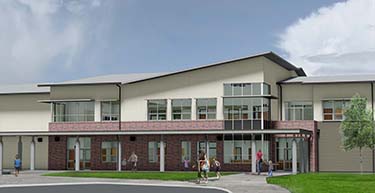|
Subscribe / Renew |
|
|
Contact Us |
|
| ► Subscribe to our Free Weekly Newsletter | |
| home | Welcome, sign in or click here to subscribe. | login |
News
| |
 |
August 25, 2016
Lynden Elementary: from concept to completion in 22 months flat
Studio Meng Strazzara

Erwood
|

Lee
|
Students in the northwestern corner of Washington will begin their academic year in September 2017 in a brand new school completed an entire year earlier than expected.
The facility will complete construction just 22 months after the design began. That’s much less than a typical project of its kind.
The current Fisher Elementary School is a 550-student facility located just 5 miles from the Canadian border in the town of Lynden. The new school will be constructed around the existing one and will be 20,000 square feet larger to support the growing community.
The new school will include 28 classrooms spread across two floors, shared learning and project areas as well as a library, commons and administration offices. The building has been designed to Washington Sustainable Schools Protocol standards and will have a variety of energy-efficient strategies. Its new placement on the site highlights views to an existing greenbelt.
Delivering construction documents for the 66,000-square-foot facility in seven months is the result of a well-thought-out and executed project plan, a strong and supportive team of experts and stakeholders, and a commitment to designing efficient schools.
A new option
At the start of the project, the Lynden School District was planning to replace its middle school first, after which the elementary students would be moved into the old middle school while the new elementary school was constructed.
Our team presented a new option: Build the new elementary school on the existing school’s site. After careful evaluation of the existing site plan, coupled with our experience working on already-occupied sites, the district accepted this change of approach.
The result will allow the development of the middle and elementary schools autonomously, save money on escalation and moving costs, and help deliver the new facility sooner. It also means that students will not have to endure the disruption of moving.
The district used the saved money to fund an additional 4,000 square feet for a large gymnasium for use by both the school and the surrounding community.
Fast-track decisions
For a fast-tracked project like this to work, it’s imperative that key decision-makers respond quickly and cohesively. For this project, key stakeholders were brought together to make real-time decisions. This included having the district’s participation in regularly scheduled design meetings and focusing on maximizing their time to decide on solutions.
Because of the cooperative effort between the Lynden School District superintendent and the Fisher Elementary principal, the design team was able to put the project out to bid in June, only seven months after concept design began. The project bid under budget at $233 per square foot.
To further fast-track efforts, design ideas, plans and processes were shared with the city and local jurisdictions early and proactively to aid in response times and minimize the wait time that comes from multiple revisions.
Also crucial to helping the design team making decisions quickly and keeping the project moving forward was the use of building-information modeling in communication with the district. Weekly coordination meetings brought the team together to check for inconsistencies in the model and to keep the entire team on the same page through design changes.
Local design partner
Going beyond the tools and processes outlined in the project plan, the project’s success was due in large part to the partnership between Seattle-based Studio Meng Strazzara and Bellingham-based Zervas Architects.
Both firms brought to the project an expertise in school design and construction and each firm’s strengths and assets were leveraged for maximum efficiency. Studio Meng Strazzara and Zervas collaborated throughout the design process then facilitated the creation of the construction documents, which required fast turnaround.
The project is now under construction, with Zervas Architects managing construction administration, as the firm’s nearby location allows them fast access to the site to address any needs and provide regular updates to the team.
More efficient design
In conjunction with a detailed project plan and strong team, we focused on designing for efficiencies. After touring several newer schools and speaking with the teachers and administrators within those schools, we focused on which spaces were most successful and how best to integrate them within our design.
While the original educational specifications did not include shared learning spaces, our team worked to streamline support and custodial spaces, and by doing so was able to provide the needed square footage to accommodate the new shared areas.
Six flexible learning spaces were incorporated within classroom groupings, as well as a project space adjacent to the library. The project space allows for further breakout for the teachers, and will also be utilized by the librarian for additional curriculum.
Green design
As part of the effort to design and construct the school in just 22 months, the team focused on using resources and expertise available in the area.
Wood framing allowed for a faster construction schedule, and was an important part of the design to create a more natural aesthetic that matches the site and surrounding area. Not only is it more cost effective, but local labor has experience constructing buildings with wood, reducing subcontractors brought in from outside of the area and saving time.
Passive sustainable methods, including the building’s orientation, clerestory windows, operable windows and displacement ventilation, will provide a well-lit and healthy environment for learning, and all flooring and paint finished are low-VOC. The common areas and cafeteria are oriented to take advantage of the greenbelt located behind the school, and provide a visual connection to nature that the existing building is lacking.
Colacurcio Brothers Construction Co. broke ground in July and the school is scheduled to open for classes in September 2017.
Principal Dennis Erwood and Director Steve Lee lead the education studio at the Seattle-based architecture and design firm Studio Meng Strazzara.
Other Stories:
- When does renovating a school mean bringing it ‘up to code’?
- New Mount Si High will sit atop 4,800 stone columns
- How to design a school restroom that works for everyone
- School projects in remote Alaskan villages face tall hurdles
- Learning center in Tacoma Park will serve students and the community
- Clark College creating a regional hub for STEM
- ‘Dark,’ ‘maze-like’ student union gets a big makeover
- Tahoma School District responds quickly to surging enrollment



